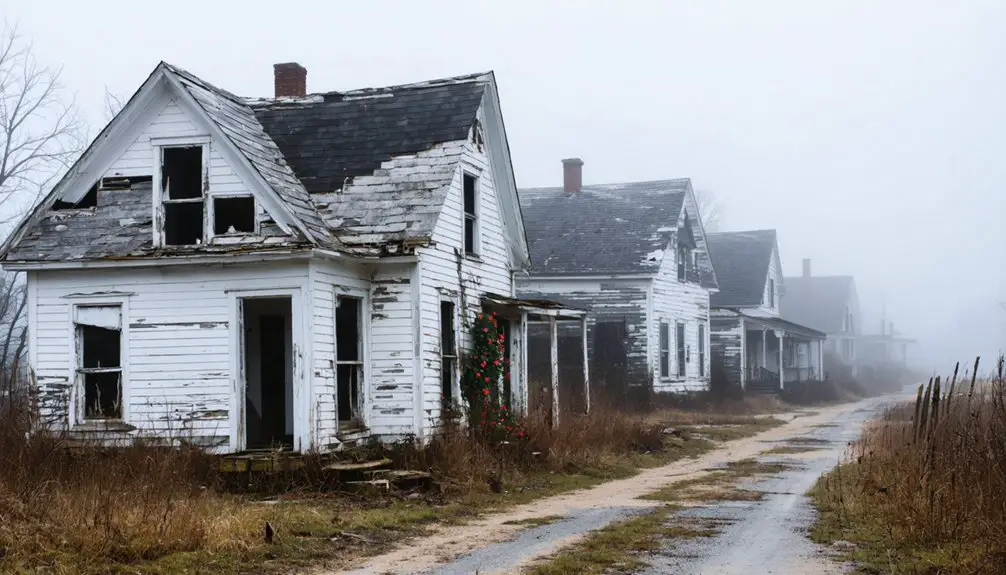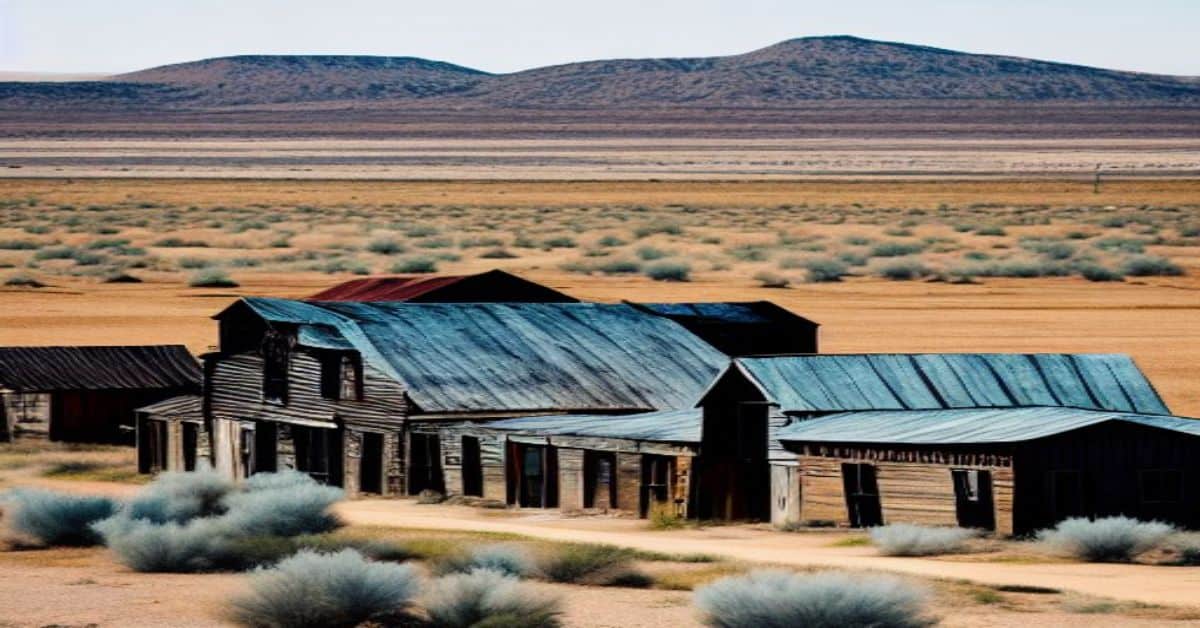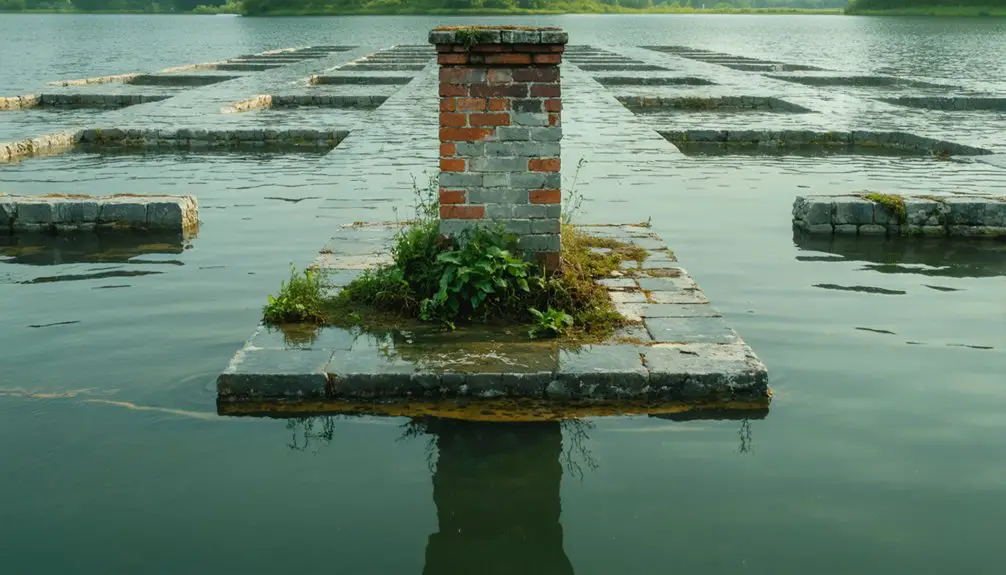Off Cape Cod’s coast, you’ll find the submerged ruins of Whitewash Village, established in 1710 on Monomoy Island. This maritime settlement thrived around Powder Hole harbor, supporting 200 residents through fishing and mining operations by the 1800s. The devastating Great Storm of 1860 filled the harbor with sand, forcing residents to float their homes to the mainland. Today, local legends tell of mysterious figures wandering through the fog where this “Chatham’s Lost Atlantis” once stood.
Key Takeaways
- Whitewash Village, established in 1710 on Monomoy Island, Massachusetts, was a thriving maritime community that became a ghost town after 1860.
- The Great Storm of 1860 filled Powder Hole harbor with sand, destroying the village’s vital fishing economy and forcing residents to abandon their homes.
- Residents demonstrated remarkable resilience by floating their homes on rafts to the mainland after the devastating storm destroyed their livelihoods.
- The submerged village earned the nickname “Chatham’s Lost Atlantis” due to its underwater remnants visible during extremely low tides.
- Local legends tell of mysterious figures in the fog and ghostly apparitions where the once-prosperous fishing village stood.
A Maritime Settlement Takes Root (1710-1711)
As coastal Massachusetts was experiencing growth in maritime settlements during the early 18th century, Whitewash Village emerged on Monomoy Island in 1710.
The settlement origins centered around a deep natural harbor called Powder Hole, which would prove essential to the community’s maritime heritage. The village focused heavily on cultural traditions that shaped its early identity.
You’ll find that early settlers quickly established themselves through a mix of fishing activities and livestock grazing on the island’s inland pastures. A prominent addition to the growing settlement was the construction of a well-known tavern in 1711.
Life in The Land of Evil Bars
While treacherous coastal hazards earned the area its ominous nickname “The Land of Evil Bars,” Whitewash Village’s inhabitants adapted to life among the dangerous shoals and shifting sandbars.
You’d find villagers mastering dual roles – rescuing shipwrecked sailors while practicing controversial salvaging ethics that sometimes involved deliberately causing wrecks for profit. Their fishing techniques centered on cod, mackerel, and lobster catches, which they’d sell cheaply to mainlanders. The thriving seafood trade helped sustain the village’s nearly 200 residents.
Despite isolation, you’d witness a remarkably structured society. The village maintained a year-round school with four terms, often led by fishermen’s wives. A fierce hurricane in the 1860s combined with declining fish populations eventually led to the village’s demise.
Isolated yet organized, Whitewash Village thrived with its four-term schoolhouse where fishermen’s wives educated the next generation.
Life wasn’t easy – in 1859, residents still sought basic amenities like outhouses. Strong currents and treacherous tides between Nantucket Sound and the Atlantic constantly threatened their maritime activities, yet the community persisted through mutual support.
The Powder Hole Harbor’s Golden Age
During its peak in the mid-1800s, Powder Hole Harbor transformed from a modest fishing settlement into a bustling maritime hub of 200 residents. The community was established in 1711 as a settlement and grew steadily over the following decades. A vibrant lobster fishing colony operated along the harbor’s edge.
You’d find significant economic growth driven by a thriving mining operation that produced 20 tons of ore daily by 1883. The community development flourished with the construction of essential infrastructure, including two wharves, ore processing facilities, and a tramway.
- A self-sufficient village emerged with a company store, post office, and mining school
- The harbor served as a crucial gateway for shipping, trade, and passenger transport
- Ten industrial buildings supported mining operations, while a dozen houses, tavern, and inn formed the residential core
This golden age showcased the perfect blend of maritime activity and industrial progress, creating a thriving coastal community before environmental changes altered its destiny.
Wreckers, Sailors, and Village Characters
During Whitewash Village’s heyday, you’d find an intriguing mix of characters around the tavern, from legitimate sailors seeking refuge to notorious wreckers who salvaged – and sometimes deliberately lured – ships to destruction along the treacherous coastline.
The village’s economy thrived on this morally ambiguous balance between rescue and wreckage, with locals taking on dual roles as both lifesavers and opportunistic salvagers in the area known as “The Land of the Evil Bars.”
The tavern, established in 1711, served as the social heart of this maritime community, where fishermen, teachers, and drifters alike would gather to share tales of the sea and conduct business amid the harsh realities of coastal life. Though the village once supported a bustling population of about 200 residents, its community life was ultimately cut short when a devastating hurricane struck in 1860.
The village focused heavily on fishing and seafood, supplying fresh catches to the bustling markets of Boston and New York.
Life of Seafaring Characters
At its peak in the early 19th century, Whitewash Village thrived as a bustling maritime community of nearly 200 residents who made their living primarily from the sea.
You’d find a tight-knit community of fishermen, lobstermen, and sailors pursuing their maritime livelihoods amidst the village’s essential infrastructure of shipyards, chandlers, and wharves. Stewarts Tavern on Inward Point was one of the earliest establishments, opening in 1711.
- Ship captains and crew relied on the Monomoit House tavern as their social hub and refuge from treacherous waters.
- Seafaring traditions centered on cod, mackerel, and lobster fishing, with lobsters selling for mere cents.
- Families adapted to coastal life, operating supply stores and maintaining vessels despite environmental challenges.
The village’s character was shaped by these resilient seafarers who persisted in their way of life until shifting sands and storms eventually forced them to abandon their homes. The community’s origins traced back to when European settlers established their first sporadic settlements on Monomoy in the 18th century.
Village’s Notorious Shipwreck Hunters
The treacherous waters around Whitewash Village earned the ominous nickname “The Land of the Evil Bars,” where local inhabitants played a complex dual role as both lifesavers and opportunistic wreckers.
You’d find prominent “Captains” leading salvage crews, alongside the vigilant Monomoy Point Light keeper and specialized divers who’d brave dangerous shores. Their wrecker ethics were questionable – some deliberately misled ships with false navigational aids, while others focused on legitimate salvage techniques.
The notorious reputation of certain wreckers served as a warning to passing vessels. When fishing declined, these maritime specialists turned to shipwreck recovery for survival. They’d salvage everything from cargo to entire structures, supporting their families through the trade.
The Elsie M. Smith incident of 1902 highlighted their contradictory nature – saving lives while profiting from maritime disasters.
Tavern Social Gatherings
Nestled along the treacherous shores of Cape Cod, Stewart’s Tavern and Monomoit House emerged as crucial social hubs where wreckers, sailors, and local characters converged amid the harsh maritime environment.
You’d find a diverse mix of patrons sharing tavern tales over rum, cider, and local brews, creating bonds that strengthened the coastal community‘s resilience.
- Fishermen and traders exchanged crucial maritime news while seeking shelter from long expeditions.
- Wreckers gathered to discuss salvage operations and potential opportunities along the dangerous coast.
- Local farmers and merchants supplied provisions, fostering communal bonding through shared resources.
The taverns’ unique “amphibious” nature, especially at Monomoit House where high tides reached the front stairs, added to their mystique as gathering spots where you’d hear stories of shipwrecks, maritime adventures, and coastal life.
Nature’s Fury and the Great Storm of 1860
You’ll find few natural events as transformative to a community as the Great Storm of 1860, which swept away Monomoy Island’s northwest point and filled Powder Hole harbor with sand.
The once-protected anchorage became too shallow for vessels, devastating the village’s maritime economy and forcing residents to abandon their fishing livelihoods.
In a remarkable display of determination, some villagers even floated their homes on rafts to the mainland, marking the beginning of a mass exodus that would leave Whitewash Village forever changed.
Storm’s Devastating Impact
During the winter of 1859-1860, a catastrophic storm swept through Monomoy Island, forever altering its geography and sealing the fate of Whitewash Village.
The storm’s aftermath was devastating, eroding the northwest point and transforming the village’s essential lifeline – Powder Hole harbor. You’d have witnessed nature’s raw power as extreme weather and flooding reshaped the coastline, filling the deep harbor with sand until it became too shallow for fishing vessels.
- Village resilience crumbled as the harbor’s destruction crippled the local fishing economy.
- Residents watched helplessly as their primary source of income – cod, mackerel, and lobster fishing – became impossible.
- Fish migration patterns shifted dramatically, further diminishing the community’s chances of recovery.
The storm’s impact proved insurmountable, forcing villagers to ponder abandonment as their only path to survival.
Harbor Filled With Sand
The Great Storm of 1860 released its most devastating blow when massive quantities of sand flooded into Powder Hole harbor, transforming the once-thriving maritime sanctuary into a shallow, unusable basin.
This sedimentation effectively destroyed the village’s economic lifeline, as fishing vessels could no longer navigate or dock in the harbor’s reduced depths.
The harbor ecology suffered immediate and lasting damage. You’d have seen dramatic changes as cod, mackerel, and lobster populations abandoned their formerly rich habitat.
The storm’s reshaping of Monomoy’s coastline wasn’t limited to just filling the harbor – it swept away the northwest point of the island and began a pattern of ongoing geographical transformation.
Infrastructure crumbled as docks and wharves became obsolete, forcing villagers to dismantle their homes and flee to the mainland.
Community’s Forced Mass Exodus
As devastating waves pounded Monomoy Island in 1860, Whitewash Village’s tight-knit community faced an unprecedented crisis that would forever alter their lives.
You’ll find that after the harbor’s destruction, rapid economic decline forced residents to abandon their homes, marking the end of a once-thriving fishing settlement. In a remarkable display of resourcefulness, some villagers even floated their dismantled houses on rafts to the mainland.
- Many families had no choice but to relocate as fishing became impossible.
- The community displacement happened swiftly, with the village nearly empty by mid-1860s.
- Attempts to resettle proved futile due to the harbor’s permanent damage.
The mass exodus marked a point of no return for Whitewash Village, as the destruction of its harbor eliminated any possibility of maintaining the community’s traditional way of life.
Legends and Lore of an Underwater Ghost Town
Local legends tell of mysterious figures wandering through fog-shrouded waters where Whitewash Village once stood, earning it the nickname “Chatham’s Lost Atlantis.”
Maritime folklore surrounding this submerged settlement includes tales of shipwrecked sailors’ spirits, ghostly apparitions spotted during rare low tides, and haunting stories tied to the treacherous Pollock Rip shoals.
You’ll find these stories deeply rooted in the village’s history as a maritime refuge, where sailors sought shelter from storms and dangerous waters.
Former residents have reported glimpsing underwater remnants of their old community during exceptionally low tides, adding to the mystique of this lost settlement.
The village’s gradual surrender to the sea, combined with its role as a sanctuary for desperate mariners, has transformed it into a powerful symbol of nature’s dominance over human settlement.
Frequently Asked Questions
What Happened to the Original Cemetery and Grave Sites of Whitewash Village?
You’ll find the original cemetery was partially destroyed by storms and railroad construction, with grave site preservation efforts including retaining walls built in 1885 after many graves washed away, hampering cemetery restoration.
Were Any Valuable Artifacts Recovered From the Underwater Village Ruins?
While millions dreamed of treasure, you won’t find significant underwater discoveries there. Historical artifacts from the ruins are limited to deteriorating structural remains, with BUAR restricting removal to protect archaeological integrity.
Did Any Original Whitewash Village Families Continue Living in Nearby Chatham?
You can’t definitively confirm family legacies continued in Chatham, though it’s likely some residents relocated there. Without explicit documentation of Chatham connections, direct lineages remain uncertain despite probable migration patterns.
What Was the Average Annual Income of Whitewash Village Fishermen?
Like fish slipping through nets, precise income records elude you. Based on the fishing economy’s documented prices and regional patterns, you’d estimate modest annual earnings around $200-300 for typical village fishermen.
How Many Buildings Were There in Whitewash Village at Its Peak?
You’ll find around 20-30 buildings spread across the village layout, including homes, shipyards, storage sheds, the Monomoit House, chandlers, and School #13 – all arranged around the harbor area.
References
- https://tomscapecod.com/blogs/post/whitewash-village-chatham-s-lost-atlantis
- https://bostonuncovered.com/ghost-towns-massachusetts/
- https://newenglandhistoricalsociety.com/six-new-england-ghost-towns/
- https://historyofmassachusetts.org/ghost-towns-massachusetts/
- https://kids.kiddle.co/Whitewash_Village
- https://www.us-lighthouses.com/monomoy-point-lighthouse
- https://www.wikiwand.com/en/map/Whitewash Village
- https://etourchatham.org/monomoy_quick_history.html
- https://historicmassachusetts.org/first-period/
- https://www.lighthousefriends.com/light.asp?ID=611



